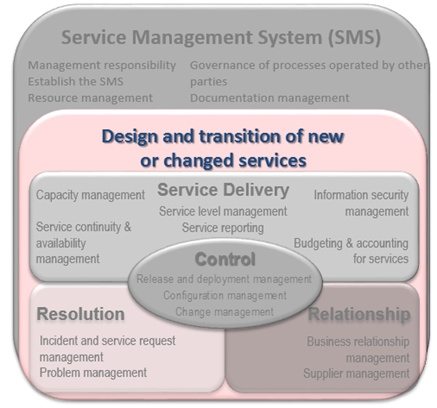 Drago Topalovic
Drago Topalovic
July 15, 2014
I would like to quickly address an interesting set of requirements under 5. Design and transition of new or changed services in ISO/IEC 20000. This chapter deals with changes of an existing service pool, a process which can create quite a bit of disturbance in a service provider’s service management system. How do these requirements help to bring order and peace in the process?
In the previous (2005) version, point 5. was titled Planning and implementing new or changed services and it consisted of 7 requirements. Version 2011 brought a significant rewrite with 26 elaborate requirements. This surely tells us something about the importance of the process.

If you are new to IT service management, you will probably want to spend a lot of time on Resolution processes. As you progress, more attention will be given to Control processes. Management naturally tends to focus on Service delivery. Sometimes we all assume that we live in a fixed, never-changing IT ecosystem. Which is, of course, never true.
The existing services are being changed frequently due to customer requirements and technology changes. These are large changes, which can deeply impact the provider’s service management system, since they influence absolutely every aspect and process.
This set of ISO20k requirements is carefully derived from best practices, and it describes common denominators of introducing/changing services in a service management system. In practice, this chapter will help the provider to tidy up the system and to engage parts of the company that may be outside of the system scope (typically development, finance, etc.) to provide the required deliverables necessary for a smooth introduction of services into the operation.
In ISO20k, every new/changed service has to go through three stages: Plan, Design/Development and Transition.
Plan – On a strategic level, a new service has to be evaluated against business requirements, available resources, financial parameters and technology competencies. These requirements will be interfaced to company strategy and adopted project management methodologies.
Design and development – In a design phase it all comes down to project management in IT, and as we know, deliverables and timetables can vary, depending on architectural, networking and software development portions of the new service. On the service management system side, it is important to identify points of influence on the existing system, for example whether there will be changes in SLAs, service catalog or documentation. Since development and service management differ in so many ways, it is sometimes practical to leave the development/architectural units outside of the scope and treat them as external suppliers. Just a thought.
Transition – Since the change is the mother of most incidents, this stage should be conducted with utmost care. All requirements should be considered carefully, and ITIL best practices should be consulted for any gray areas, especially for early life support. New/changed services should be introduced in a VERY controlled manner. Depending on the scale of the service, solution quality, and testing intensity, new/changed services tend to introduce bursts of incidents in the beginning. This can be very stressful for support staff. Therefore, it is important to include developers in the early life support. This will speed up the removal of glitches from new solutions, and also the knowledge transfer to service management people.
We have already mentioned several times that almost every requirement in ISO20k makes sense if you consider it carefully. Depending on the ISO20k implementation methodology, chapter 5 tends to be more or less neglected since most of implementers focus hard on resolution and control processes, saving the top-level process groups for last. This is one of the reasons to think about including an experienced standard implementer in the project. They tend to smooth this effort curve and take care of satisfying at least the minimum requirements that will be presentable to the external auditor.
Even if you satisfy just these minimal requirements in Design and transition of new or changed services in your system, you will notice a significant improvement in all other service management processes. This will probably motivate you to take some additional care of it during the first year. A man/hour spent here goes a long way.
You can also check out a free sample of the Design and Transition of New or Changed Services Process to learn how to fulfill ISO/IEC 20000 requirements for clauses 5.1. – 5.4.